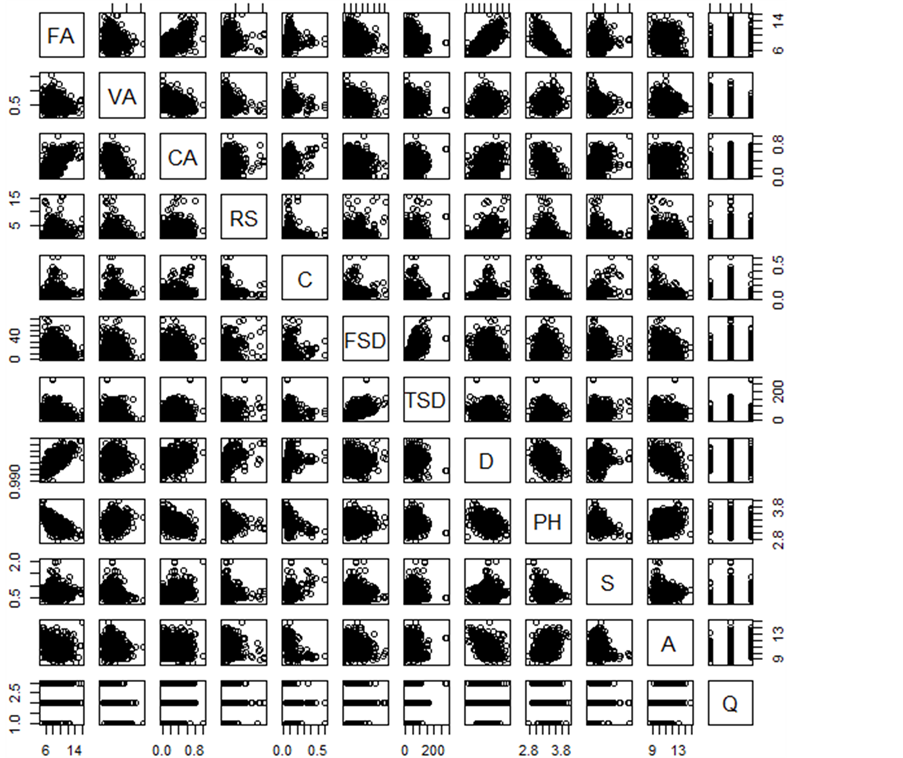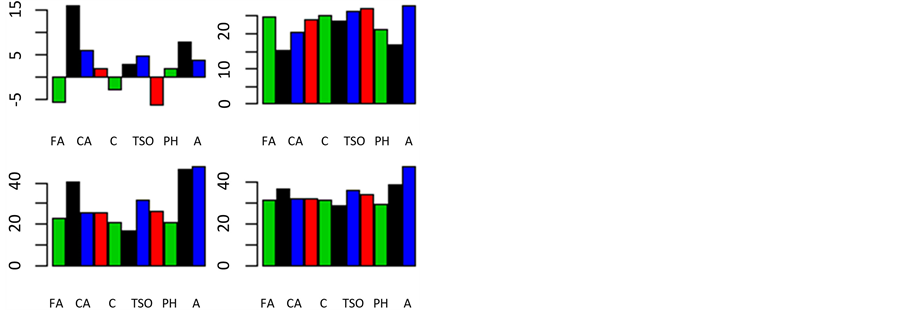1. 研究背景
葡萄酒是用葡萄果实或葡萄汁,经过发酵酿制而成的酒精饮料。在水果中,由于葡萄的葡萄糖含量较高,贮存一段时间就会发出酒味,因此常常以葡萄酿酒。葡萄酒是目前世界上产量最大、普及最广的单糖酿造酒。早在六千年以前,在盛产葡萄的地中海区域,两河流域的苏美尔人和尼罗河流域的古埃及人就会酿造葡萄酒。有趣的是,在舞蹈文化中,有一种葡萄酒舞是在酿酒用葡萄丰收时,庆祝的团体舞蹈。葡萄酒在基督教被视为耶稣基督宝血的象征物。随着科学研究,科学家们发现葡萄酒中含有许多的糖、氨基酸、维生素以及矿物质,都是人体必不可少的营养素,使得葡萄酒有滋补、消化、杀菌、利尿、延缓衰老、防治脑血栓、预防癌症、预防乳腺癌、促进新陈代谢、保护心肌、预防心脏病、软化血管、预防糖尿病、养肺保肺、适量喝红葡萄酒能减少患老年痴呆症危险、防治肾结石等功效与作用,而且葡萄酒有增进食欲、供给热量、缓解疲劳,减肥、美容养颜、防治视网膜变性、有助于提高记忆力以及防治感冒等好处。葡萄酒有这么多对人体有益的作用,葡萄酒在欧美等地区十分受人们的喜爱。近年来,随着我国的经济不断的发展,人们的生活水平不断地提高,我国消费者越来越喜欢葡萄酒,而且对葡萄酒品色和质量的要求不断提高。因此葡萄酒的质量越来越受到广大消费者的关注,而且我国的葡萄酒已经从初级阶段进入到一个发展阶段[1] 。如何能够准确地鉴定葡萄酒的质量成为消费者和生产者最关心的问题?传统上,我们都是通过人工品尝打分来进行鉴定葡萄酒的质量,我们要求专业的品酒师通过自己的专业素质根据自己的感官体验(葡萄酒的香气,口感以及外观等指标)来评定葡萄酒的质量。然而这种人工品尝鉴定往往易受到品酒师个人的嗜好、经验以及习惯等因素的影响。这导致葡萄酒的质量会受到品酒师的主观性影响,使得葡萄酒的质量鉴定结果并不是十分可靠。然而不管是国外的葡萄酒市场还是国内的葡萄酒市场都没有一个十分完善的葡萄酒质量标准。葡萄酒的一些理化指标还是能够较为客观的反映葡萄酒质量的好坏。为了使葡萄酒质量鉴定更为科学可靠,不少的学者提出了许多关于葡萄酒质量评定的统计模型和数据挖掘方法[2] [3] 。
国外有许多的学者基于葡萄酒的理化指标(例如:酒精的浓度、pH值、糖的含量、非挥发性酸含量、挥发性酸含量、柠檬酸含量等)以及结合现代的科学技术手段研究葡萄酒的质量。在1997年,L.Sun等人基于数据挖掘中的人工神经网络方法来预测葡萄酒的质量。在1999年,Ebeler等人基于葡萄酒的理化指标评估以及感官测试来鉴定葡萄酒的质量[4] 。而在2001年,S.Vlassides等人使用NNs最近邻分类器来预测葡萄酒的质量。随着科技的不断发展,葡萄酒样本的数目不断增加,在2009年,Cortez等人通过使用支持向量机方法来预测葡萄酒的质量,当时的样本数达到了1000多,使用的理化指标多达10个[5] 。
而在国内,对于葡萄酒质量的研究相对于国外较晚,在2009年,李运,李记明等人通过了解葡萄酒中的成分与感官之间的相关性来研究葡萄酒质量问题,他们提出通径分析、相关性分析、变异系数分析、主成分分析来研究葡萄酒质量的预测,他们使用了将近20多个理化指标[6] 。2012年,张浩彬提出使用数据挖掘方法来预测葡萄酒质量,他主要使用Logistic多项式模型,Tan神经网咯,带偏差项的BP神经网咯,决策树,Bagging,Adaboost,最近邻方法等数据挖掘方法。2013年,裴慧宇提出基于理化指标的Logit模型来预测葡萄酒质量,她运用主成分分析,聚类分析对葡萄酒中的主要理化指标进行归类以及筛选,使用Logistic模型预测葡萄酒质量。2013年,陈欣提出建立多元线性回归模型,从而通过回归方程得到葡萄酒质量预测质量得分,将其与实际评分进行误差分析。
国内外的学者提出的方法均能很好通过葡萄酒的理化指标以及葡萄酒的口感等因素预测葡萄酒的质量,但是美中不足的是,他们的预测精确度均在85%以下,本文主要是基于支持向量机方法[7] -[9] 的改进,使得预测精度提高。由于支持向量机核函数的线性组合还核函数,本文主要基于支持向量机常用核函数的线性组合,得到新的核函数,使得误判率最小。也就是预测精度最高。
2. 模型构建
支持向量机(support vector machine)是一种分类算法,通过寻求结构化风险最小来提高学习机泛化能力的机器学习方法,最早是由Vapnik在20世纪90年代所提出的。为了实现经验风险和置信范围的最小化,从而使得在统计样本量较少的情况下,亦能获得良好统计规律的目的。其基本思想是通过最大化分类之间的间隔来达到经验风险和置信范围的最小。通俗来讲,它是一种二类分类模型,其基本模型定义为特征空间上的间隔最大的线性分类器,即支持向量机的学习策略便是间隔最大化,最终可转化为一个凸二次规划问题的求解。
已知n类数据样本训练集: 上标代表类别数,
上标代表类别数, 代表第
代表第 类训练样本数,训练集样本总数为
类训练样本数,训练集样本总数为 ,其中
,其中 ,
, ,
, 代表类别数。
代表类别数。 上的一个判别函数
上的一个判别函数 ,对于任一个输入
,对于任一个输入 都有对应的
都有对应的 输出值。利用二值分类方法构造n类分类器的方法步骤:
输出值。利用二值分类方法构造n类分类器的方法步骤:
1) 首先构造n个二值分类器, 将第
将第 类的训练样本和其他训练样本集分开。如果样本
类的训练样本和其他训练样本集分开。如果样本 属于第
属于第 类,则有
类,则有 ;否则
;否则  。
。
2) 然后,寻找函数 ,
, 中最大值所对应的类别即为
中最大值所对应的类别即为 的类别:
的类别:

对于回归问题, 不仅仅可以是
不仅仅可以是 和1。如果令
和1。如果令 ,希望
,希望 与
与 的离差越小越好,那么问题就可以归结于求一个
的离差越小越好,那么问题就可以归结于求一个 使得
使得 取得最小值,但是其约束条件为
取得最小值,但是其约束条件为 ,这里
,这里 是某一个目标值,这里允许出现一些误差,这样就可以将上面的约束减弱为(对于大于0的
是某一个目标值,这里允许出现一些误差,这样就可以将上面的约束减弱为(对于大于0的 )
) 和
和 ,就可以得出Lagrange函数:
,就可以得出Lagrange函数:

需要在约束的条件下 下,解
下,解 问题。
问题。
当样本是线性可分时,支持向量机(SVM)算法可以通过构造线性的最优分类超平面 ,能够将两个类别的样本十分准确地分开。而当样本不是线性可分时,支持向量机(SVM)算法可以通过非线性的映射,将原样本映射到高维特征空间,其映射为:
,能够将两个类别的样本十分准确地分开。而当样本不是线性可分时,支持向量机(SVM)算法可以通过非线性的映射,将原样本映射到高维特征空间,其映射为: 。
。
一个支持向量机(SVM)具有良好的性能,关键是核函数的构造,核函数的构造主要包括两个部分的工作:一是核函数的类型构造,二是在确定好核函数的类型后一些相关参数的选择,因此如何根据具体的数据来构造合适的核函数,是支持向量机(SVM)应用领域遇到的一个重大难题,这也成为了研究人员所关注的焦点,即便如此,现在依然没有具体的理论和方法来指导构造合适的核函数。
其核函数的定义并不困难,只需要根据泛函的有关理论,如果有一种函数 能够满足Mercer条件,那么它就对应某一变换空间的内积。目前根据Mercer定理可以得到以下几种常用的核函数类型:
能够满足Mercer条件,那么它就对应某一变换空间的内积。目前根据Mercer定理可以得到以下几种常用的核函数类型:
(1) 线性核函数: ;
;
(2) 多项式核: ;
;
(3) 径向基核(RBF): 高斯径向基函数则是局部性强的核函数,其外推能力随着参数
高斯径向基函数则是局部性强的核函数,其外推能力随着参数 的增大而减弱。多项式形式的核函数具有良好的全局性质。局部性较差;
的增大而减弱。多项式形式的核函数具有良好的全局性质。局部性较差;
(4) 傅里叶核: 。
。
在本文根据核函数的一些性质:
性质1: 是核函数,当且仅当它是正定的。
是核函数,当且仅当它是正定的。
性质2:若 是核函数,则
是核函数,则 是核函数;
是核函数; 是核函数;
是核函数; 是核函数。
是核函数。
对训练集 ,拟合函数
,拟合函数 可以通过求解下面的最优问题得到下式。
可以通过求解下面的最优问题得到下式。




其中, 为训练集的样本数,
为训练集的样本数, 为惩罚因子,主要调节回归函数的准确率,值越小准确率越高,如果过小的话,会出现过拟合现象。而
为惩罚因子,主要调节回归函数的准确率,值越小准确率越高,如果过小的话,会出现过拟合现象。而 和
和 为松弛因子。将上面的式子进行对偶化,并将其转化成半正定规划的标准形式,这样方便用Matlab求解,上式可转化成下面式子
为松弛因子。将上面的式子进行对偶化,并将其转化成半正定规划的标准形式,这样方便用Matlab求解,上式可转化成下面式子


其中, ,
, 为单位向量,
为单位向量, ,
, 为非负的不敏感损失函数的参数。
为非负的不敏感损失函数的参数。 ,
, 。由性质2可以知道,核函数的线性组合仍为核函数,因此可以通过上面介绍4种的常用的核函数来构造出对应的实际数据最优核函数。先对核函数矩阵进行归一化,也就是对原核做一个特征映射:
。由性质2可以知道,核函数的线性组合仍为核函数,因此可以通过上面介绍4种的常用的核函数来构造出对应的实际数据最优核函数。先对核函数矩阵进行归一化,也就是对原核做一个特征映射: ,归一化后的核矩阵线性组合,要满足条件:
,归一化后的核矩阵线性组合,要满足条件:

其中, 为初始核函数矩阵集,
为初始核函数矩阵集, 为目标向量,可以得到目标函数为:
为目标向量,可以得到目标函数为:


其中, 为约束参数,主要目的是约束 的迹来提高搜索效率,防止出现过拟合现象。将拉格朗日乘数应用于目标函数,那么将有约束条件的最优化问题转化成SDP的标准形式代入libsvm软件包内所提供的网格搜寻算法搜寻上面4种常用的核函数的最优参数。在求解凸二次规划时使用yalmip软件包。
3. 葡萄酒数据初步分析
3.1. 数据来源
本文实证分析所选用的葡萄酒数据来源于University of Minho提供的Wine Quality Data Set的数据(该数据集由P.Cortez等三人在2009年向UCI机器学习网站捐赠的数据,数据来源网址: http://archive.ics.uci.edu/ml/machine-learning-databases/wine-quality/),该数据集共计1599个样本,包含了11个葡萄酒的理化指标和化学指标,还有一个表示葡萄酒质量的指标。本文根据前人的一些研究,将葡萄酒质量的指标分成三个质量等级,分别为高等、中等以及低等,其分别对应的样本数为217、1319、63。本文使用libsvm软件包、yalmip软件包以及R软件对数据进行分析。
3.2. 数据变量说明
fixed acidity (非挥发性酸):fixed acidity的含量会影响葡萄酒的口感。fixed acidity是指酒石酸的含量,这种酸在葡萄酒加热时不会挥发出去。fixed acidity是连续变量。
volatile acidity (挥发性酸):volatile acidity是指醋酸的含量,这种酸在葡萄酒加热时会挥发出去。volatile acidity是连续变量。
citric acid (柠檬酸):citric acid主要用于抑制有害细菌的发育和去除葡萄酒中多余的铁以及铜。citric acid是连续变量。
residual sugar (残余糖分含量):residual sugar主要反映葡萄酒的甜度,其会让葡萄酒的酒味更加的柔和。residual sugar是连续变量。
chlorides (氯化钠):chloride主要影响葡萄酒的适口性。chloride是连续变量
free sulfur dioxide (游离二氧化硫):free sulfur dioxide在葡萄酒中主要有杀菌、澄清、抗氧化、增酸,其能够使葡萄酒酒的风味变好等作用。free sulfur dioxide的含量不能过高,由于其对人体有害。free sulfur dioxide是连续变量。
total sulfur dioxide (总二氧化硫):total sulfur dioxide是指葡萄酒中的游离二氧化硫和绑定二氧化硫的总含量。total sulfur dioxide是连续变量。
Density (密度):Density是指葡萄酒的密度,如果葡萄酒的密度越大,那么其口感就会越丰郁。Density是连续变量。
pH (酸碱度):pH主要影响葡萄酒的风味和颜色。pH是一个极易管理和控制的质量参数,是连续变量。
sulphates (硫酸盐):sulphates主要影响葡萄酒的香气。Sulphates是连续变量。
Alcohol (酒精含量):Alcohol能够使得葡萄酒更加具有甜润感,而且Alcohol也能反映葡萄酒的浓厚度。Alcohol是连续变量。
quality (质量):quality是指葡萄酒质量的一个指标。本文将quality分成三个质量等级,编码成1、2、3。其中1表示葡萄酒质量属于低等,2表示葡萄酒质量属于中等,3表示葡萄酒质量属于高等。这也本文的目标变量。quality是分类变量。
3.3. 数据初步分析
为了对数据有一个初步的了解,首先对数据进行标准化处理,防止一些变量的量纲对预测结果有干扰。需要知道自变量之间的相关性如何,那么就要对数据进行相关性分析,图1给出了自变量之间相关性的散点图,表1给出了自变量之间的相关性矩阵。
通过各变量之间的散点图我们可以观察到非挥发性酸与柠檬酸成线性关系而且斜率为正,则说明非挥发性酸与柠檬酸高度正相关。非挥发性酸与密度同样成线性关系而且斜率为正,则说明非挥发性酸与密度高度正相关。非挥发性酸与pH成线性关系但是其斜率为负值,则说明非挥发性酸与密度高度负相关。透过葡萄酒就各变量之间的相关性矩阵表,可以观察到非挥发性酸与密度,酒石酸与密度,非挥发性酸与柠檬酸,酒石酸与pH的相关系数均在0.60以上。除了非挥发性酸与pH,挥发性酸与柠檬酸,柠檬酸与pH的相关系数在−0.50以下,其他变量之间的相关系数均较小。说明了葡萄酒中的一些理化指标和化学成分存在着高度的相关性。

Figure 1. Scatter plots among variables
图1. 各变量之间的散点图

Table 1. Correlation matrix between variables
表1. 各变量之间的相关性矩阵
4. 葡萄酒数据实验结果
本次实验的样本数据共计1599个,所选用的试验方法分别为决策树[10] ,Bagging,Adaboost,人工神经网络[11] ,最近邻方法,随机森林[12] ,常用核函数的两个核函数(高斯和线性)的支持向量机,组合核函数的支持向量机(本文所提出的方法)来分别拟合数据,使用十折交叉验证的方法来验证本文所提出的方法是否比其他的方法效果要好(误判率是否是最低的一个)。下面分别介绍各种方法拟合葡萄酒数据的结果以及十折交叉验证的结果。
4.1. 决策树方法
决策树是我们用于拟合分类数据的方法,而且其效果往往优于经典统计的方法。本文首先使用决策树拟合葡萄酒数据,输出结果如图2、图3以及表2所示。从图2中,我们可以知道决策树在对葡萄酒进行分类时各个理化指标以及化学成分的分节点在何处,这对我们了解决策树是如何生成一棵树很有帮助。图3,这是葡萄酒数据生成的一棵决策树。最关键还是要看表3,因为表3为我们提供决策树的分类效果。从表3中,我们可以知道决策树将第一类(低等)葡萄酒全部被错分给第二类(中等)葡萄酒,第二类葡萄酒中有108个葡萄酒数据样本被错分给第三类(高等)葡萄酒,并且第三类葡萄酒中有107个葡萄酒数据样本被错分给第二类葡萄酒。计算其误判率为17.39%。虽然其误判率低于20%,但是如今的葡萄酒市场越来越大,而且随着人们生活水平的不断提高,人们对于物质的要求越来越高,那么决策树对葡萄酒质量预测的精确度就显得不够好。这就需要我们寻找对葡萄酒质量预测的精确度更高的方法。
4.2. Bagging方法
Bagging方法是数据挖掘常用的方法,其分类效果往往优于经典统计的效果。本文使用Bagging方法拟合葡萄酒数据的结果如图4以及表3所示。从图4中,我们可以看出,Bagging方法在葡萄酒数据分类时各个理化指标以及化学成分的重要性是不一样的,非挥发性酸、硫酸盐以及酒精含量在Bagging方法在葡萄酒数据分类时,重要性要大一些,其他变量重要性差不多。从最为关键的表3中,我们可以看出,我们可以知道决策树将第一类(低等)葡萄酒全部被错分给第二类(中等)葡萄酒,第二类葡萄酒中有38个葡萄酒数据样本被错分给第三类(高等)葡萄酒,并且第三类葡萄酒中有154个葡萄酒数据样本被错分给第二类葡萄酒。计算其误判率为15.94%。相比决策树效果好一些,但是其误判率还是相对有些高。

Figure 2. Decision tree output results for wine data
图2. 葡萄酒数据的决策树输出结果

Figure 3. Decision tree for wine data
图3. 葡萄酒数据的决策树

Table 2. Decision tree classification results on wine data
表2. 决策树对葡萄酒数据的分类结果

Table 3. Bagging classification results of wine data
表3. Bagging对葡萄酒数据的分类结果

Figure 4. Bagging the variables of the wine data
图4. Bagging拟合葡萄酒数据时的变量重要性图
4.3. 随机森林
随机森林方法是数据挖掘常用的方法,其分类效果往往优于经典统计的效果。本文使用随机森林方法拟合葡萄酒数据的结果如图5以及表4所示。从最为关键的表4中,我们可以看出,我们可以知道决策树将第一类(低等)葡萄酒中有50个葡萄酒数据样本被错分给第二类(中等)葡萄酒,第二类葡萄酒中有59个葡萄酒数据样本被错分给第三类(高等)葡萄酒,并且第三类葡萄酒中有143个葡萄酒数据样本被错分给第二类葡萄酒。计算其误判率为15.76%。相比决策树和Bagging方法效果好一些,但是其误判率还是相对有些高。
4.4. 人工神经网络
人工神经网络方法是数据挖掘常用的方法,其分类效果往往优于经典统计的效果。本文使用人工神经网络方法拟合葡萄酒数据的结果表5所示。从最为关键的表5中,我们可以看出,我们可以知道决策树将第一类(低等)葡萄酒中有62个葡萄酒数据样本被错分给第二类(中等)葡萄酒,第一类葡萄酒中有1个葡萄酒数据样本被错分给第三类(高等)葡萄酒,第二类葡萄酒中有60个葡萄酒数据样本被错分给第三类(高等)葡萄酒,并且第三类葡萄酒中有139个葡萄酒数据样本被错分给第二类葡萄酒。计算其误判率为16.32%。相比决策树效果好一些,但是其误判率相比于随机森林和Bagging方法略高些。
4.5. 支持向量机
支持向量机方法是数据挖掘常用的方法,其分类效果往往优于经典统计的效果。本文使用支持向量机(线性核函数)方法拟合葡萄酒数据的结果如图5以及表4所示。从最为关键的表4中,我们可以看出决策树将第一类(低等)葡萄酒全部被错分给第二类(中等)葡萄酒,第二类葡萄酒中有76个葡萄酒数据样本

Figure 5. The importance of the variables in the data of a random forest
图5. 随机森林拟合葡萄酒数据时的变量重要性图

Table 4. Classification of wine data by random forest
表4. 随机森林对葡萄酒数据的分类结果

Table 5. Classification results of grape wine by artificial neural network
表5. 人工神经网络对葡萄酒数据的分类结果
被错分给第三类(高等)葡萄酒,并且第三类葡萄酒中有120个葡萄酒数据样本被错分给第二类葡萄酒。计算其误判率为16.20%。相比决策树和Bagging方法效果好一些,但是其误判率还是相对有些高。支持向量机(线性核函数)对葡萄酒数据的分类结果如表6所示。
4.6. 支持向量机(组合核函数)
支持向量机(组合核函数)是本文基于常用支持向量机的核函数线性组合得到新的支持向量机方法。首先本文通过参数网格搜索,将惩罚因子 定位48,新核的迹约束
定位48,新核的迹约束 定为
定为 ,得到特征向量
,得到特征向量 ,则其新的核函数为
,则其新的核函数为 ,本文使用支持向量机(组合核函数)方法拟合葡萄酒数据的结果,如表7所示。从最为关键的表4中,我们可以看出,我们可以知道决策树将第一类(低等)葡萄酒中有30个葡萄酒数据样本被错分给第二类(中等)葡萄酒,第二类葡萄酒中有18个葡萄酒数据样本被错分给第三类(高等)葡萄酒,并且第三类葡萄酒中有79个葡萄酒数据样本被错分给第二类葡萄酒。计算其误判率为7.94%。相比其他数据挖掘方法都要好一些。
,本文使用支持向量机(组合核函数)方法拟合葡萄酒数据的结果,如表7所示。从最为关键的表4中,我们可以看出,我们可以知道决策树将第一类(低等)葡萄酒中有30个葡萄酒数据样本被错分给第二类(中等)葡萄酒,第二类葡萄酒中有18个葡萄酒数据样本被错分给第三类(高等)葡萄酒,并且第三类葡萄酒中有79个葡萄酒数据样本被错分给第二类葡萄酒。计算其误判率为7.94%。相比其他数据挖掘方法都要好一些。
4.7. 十折交叉验证结果
下面我们使用十折交叉验证的方法来验证究竟是那种方法最优的。十折交叉验证的输出结果如表8

Table 6. Support vector machine (linear kernel function) classification results on wine data
表6. 支持向量机(线性核函数)对葡萄酒数据的分类结果

Table 7. Support vector machine (combined kernel function) classification results on wine data
表7. 支持向量机(组合核函数)对葡萄酒数据的分类结果

Table 8. The various methods of wine classification data validation ten-fold cross-validation rate of false positives
表8. 各种方法对葡萄酒数据分类的十折交叉验证验证的误判率
所示,可以看出支持向量机(组合核函数)是这些方法中误判率最小的一个。说明支持向量机(组合核函数)的方法在对葡萄酒数据拟合效果要优于其他的常用数据挖掘方法。
5. 结论
本文首先回顾了前人对葡萄酒质量预测的一些研究,发现使用常用数据挖掘方法对葡萄酒质量预测效果太多误判率在15%以上,虽然常用数据挖掘方法的误判率都低于20%,但是如今的葡萄酒市场越来越大,而且随着人们生活水平的不断提高,人们对于物质的要求越来越高,那么决策树对葡萄酒质量预测的精确度就显得不够好。这就需要我们寻找对葡萄酒质量预测的精确度更高的方法。因此本文就提出基于支持向量机方法的改进,使得预测结果更加的精确。从前人的研究中发现,支持向量机方法的核心是核函数,只要确定了核函数,那么确定一种可用的支持向量机的方法了,而且通过前人对核函数的研究可以发现核函数的线性组合还是核函数。本文就是基于常用核函数的线性组合得到新的核函数,使得它对葡萄酒质量预测效果最好(支持向量机的核函数线性组合效果最好的一个)。通过实验发现,它不仅是支持向量机中最好的一个,也是常用数据挖掘方法中最好一个,它的误判率仅为10%左右。相对其他的方法要优秀一些。然而,本文只是简单进行线性组合,我们还可以进一步优化支持向量机的核函数使得其结果进一步好。还可以优化人工神经网络的残差项,使得人工神经网络的方法拟合数据效果更加的好。